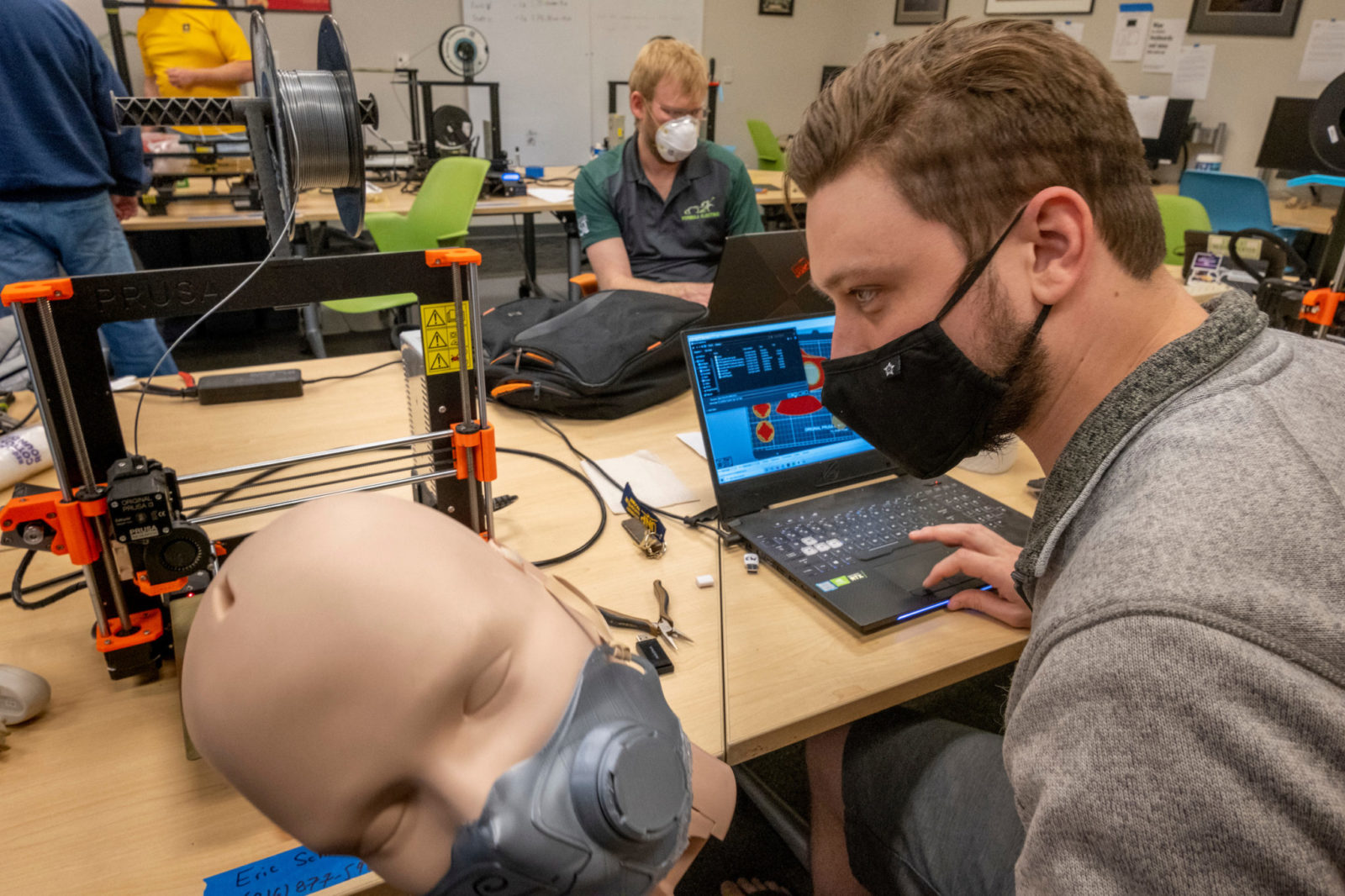When representatives from Phelps Health, anticipating a shortage of protective masks due to the coronavirus outbreak, needed help, students, faculty and staff at Missouri S&T answered by harnessing the power of technology and ingenuity.
Campus was abnormally quiet Saturday and Sunday, March 21-22, not only because it was the weekend before spring break but also because, due to the coronavirus outbreak, most students had moved out for the semester and a majority of faculty and staff prepared to work remotely. But 3-D printers in a couple of buildings on campus were humming away, fabricating prototype masks and face shield brackets.
Inside the Kummer Student Design Center, where S&T students usually work on rockets, solar cars, Mars rovers and other projects, a few students, faculty and staff outfitted one room Saturday with a dozen 3-D printers to produce prototypes for Phelps Health’s physicians, nurses and other medical workers.
Across campus, students at Missouri S&T’s Makerspace were using their 3-D printers to fabricate prototypes of the face shield brackets. The university enlisted more printers for the cause Sunday.
The S&T prototypes “are phenomenal,” says Dr. Casey Burton, director of medical research at Phelps Health.
Although there are no confirmed cases of COVID-19 in Rolla, Burton and Shawn Hodges, Phelps Health’s director of ancillary and surgical services, foresaw the need to obtain more protective gear for the Rolla-based regional health system.
“Shawn had already been experimenting with 3-D printed masks with Rolla High School but realized he needed to drastically scale up production capacity to meet the needs of our community,” Burton says. “He reached out to me to rally the university and beyond for their support and to help organize those operations with him on our end.”
Burton asked Missouri S&T Chancellor Mohammad Dehghani if it was possible to harness the university’s 3-D printing capabilities to aid in the effort. Dehghani directed others across campus to do what they could to assist.
The Kummer Student Design Center staff and students were among the first to respond. Dr. Chris Ramsay, assistant vice provost for student design and director of the center, marshalled the few remaining student members of the center’s 19 design teams to set up a 3-D printer farm to run 24 hours a day in the center at 10th Street and Bishop Avenue.
“We started out with five” 3-D printers at the design center, Ramsay says. “I sent a note out to all the design teams, and the students who were still in town brought their printers in and now we’re up to 12.
“This has re-energized our design team students,” Ramsay says. Hundreds of S&T students had worked since the fall on projects for design competitions that are now canceled due to the coronavirus. “This community need fulfills a hunger that they have to do something positive and meaningful in this crisis.”
While the design center produced prototype surgical masks, S&T’s Makerspace chief executive officer Daustin Hoelscher, a senior computer engineering major from Mascoutah, Illinois, was printing a prototype bracket for the face shields.
Phelps Health medical staff evaluated both product prototypes on Sunday and were continuing evaluations Monday.
“This could certainly be a game changer for us and even the rest of the world, so we appreciate Missouri S&T’s efforts,” says Dr. Brian Kriete, otolaryngologist and medical director of surgical services at Phelps Health.
“I’m so pleased with how our university community has come together to help in this time of need,” says Dehghani. “The rapid response and support for one of our important community partners typifies the true S&T spirit of innovation, ingenuity and community engagement. I am very proud of the way our university has responded to this critical need.”
The Rolla Public School System is also involved in the effort, with instructors at Rolla High School, Rolla Junior High School and Rolla Technical Institute (RTI) putting their 3-D printers to use. Some students in robotics classes and teams are also helping, says Dr. Amy Hermann, RTI director.
“RTI instructors Meghan Bilbrough and Leigh Ann Carpenter also sent out an ‘all call’ to all our robotics kids, saying if they had 3-D printers, we could help the community. Several robotics kids are now printing too,” she says.
Original post https://alertarticles.info


